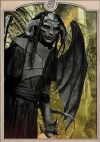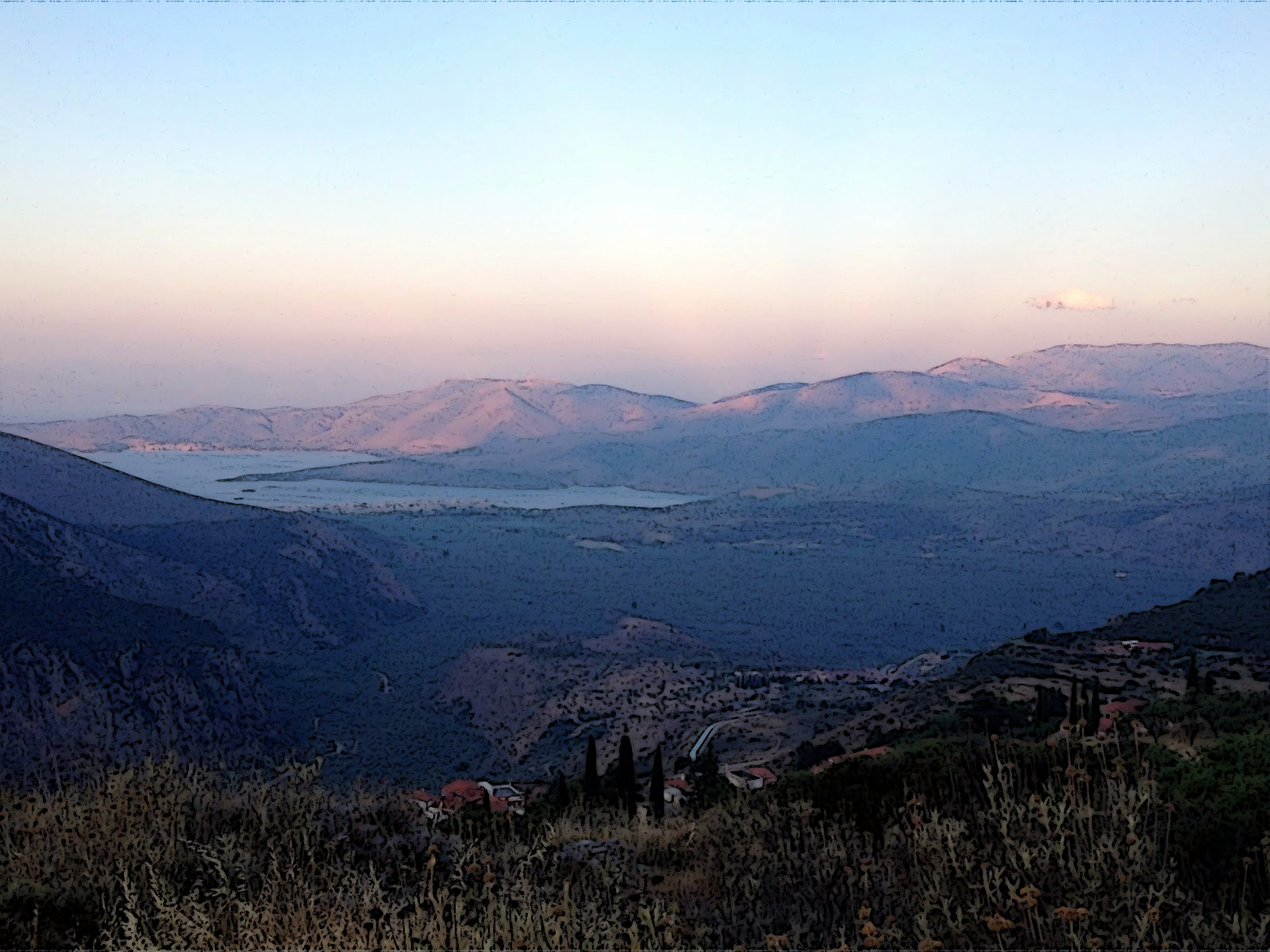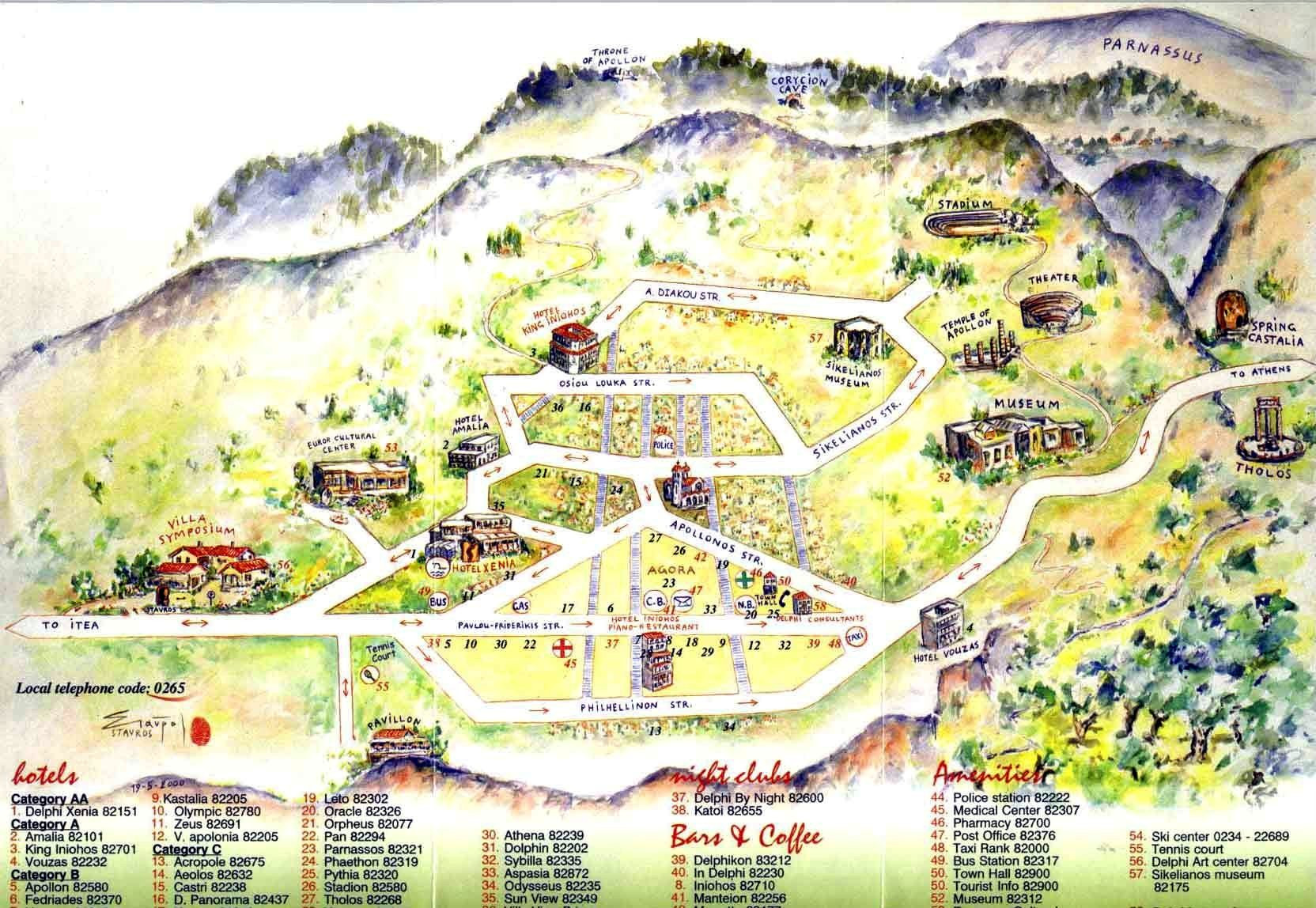Delphi
Quote
Introduction

Delphi (Greek: Δελφοί) is famous as the ancient sanctuary that grew rich as the seat of the oracle that was consulted on important decisions throughout the ancient classical world. Moreover, it was considered as the navel (or centre) of the world by the Greeks as represented by the Omphalos.
It occupies an impressive site on the south-western slope of Mount Parnassus overlooking the coastal plain to the south and the valley of Phocis. It is now an extensive archaeological site and the modern town is nearby.
It is recognized by UNESCO as a World Heritage Site in having had a phenomenal influence in the Ancient world, as evidenced by the rich monuments built there by most of the important ancient Greek city-states, demonstrating their fundamental Hellenic unity.
Origins
In myths dating to the classical period of Ancient Greece (510-323 BC), the site of Delphi was believed to be determined by Zeus when he sought to find the center of his "Grandmother Earth" (Ge, Gaea, or Gaia). He sent two eagles flying from the eastern and western extremities, and the path of the eagles crossed over Delphi where the omphalos, or navel of Gaia was found.
Earlier myths include traditions that Pythia, or the Delphic oracle, already was the site of an important oracle in the pre-classical Greek world (as early as 1400 BC) and, rededicated from about 800 BC, when it served as the major site during classical times for the worship of the god Apollo. Apollo was said to have slain Python, a "drako" a serpent or a dragon who lived there and protected the navel of the Earth.[4] "Python" (derived from the verb πύθω (pythō), "to rot") is claimed by some to be the original name of the site in recognition of Python which Apollo defeated. The Homeric Hymn to Delphic Apollo recalled that the ancient name of this site had been Krisa. Others relate that it was named Pytho and that Pythia, the priestess serving as the oracle, was chosen from their ranks by a group of priestesses who officiated at the temple.
At the settlement site in Delphi, which was a post-Mycenaean settlement of the late 9th century, there is a steady increase in artifacts from the last quarter of the 8th century BC. Pottery and bronze work as well as tripod dedications continue in a steady stream, in comparison to Olympia. Neither the range of objects nor the presence of prestigious dedications proves that Delphi was a focus of attention for a wide range of worshipers, but the large quantity of high value goods, found in no other mainland sanctuary, certainly encourages that view.
Apollo's sacred precinct in Delphi was a pan-hellenic sanctuary, where every four years, starting in 586 BC[8] athletes from all over the Greek world competed in the Pythian Games, one of the four pan-hellenic (or stephanitic) games, precursors of the Modern Olympics. The victors at Delphi were presented with a laurel crown (stephanos) which was ceremonially cut from a tree by a boy who re-enacted the slaying of the Python. Delphi was set apart from the other games sites because it hosted the mousikos agon, musical competitions.
These Pythian Games rank second among the four stephanitic games chronologically and in importance. These games, though, were different from the games at Olympia in that they were not of such vast importance to the city of Delphi as the games at Olympia were to the area surrounding Olympia. Delphi would have been a renowned city whether or not it hosted these games; it had other attractions that led to it being labeled the "omphalos" (navel) of the earth, in other words, the center of the world.
In the inner hestia ("hearth") of the Temple of Apollo, an eternal flame burned. After the battle of Plataea, the Greek cities extinguished their fires and brought new fire from the hearth of Greece, at Delphi; in the foundation stories of several Greek colonies, the founding colonists were first dedicated at Delphi.
Dedication to Apollo
The name Delphoi comes from the same root as δελφύς delphys, "womb" and may indicate archaic veneration of Gaia at the site. Apollo is connected with the site by his epithet Δελφίνιος Delphinios, "the Delphinian". The epithet is connected with dolphins (Greek δελφίς,-ῖνος) in the Homeric Hymn to Apollo (line 400), recounting the legend of how Apollo first came to Delphi in the shape of a dolphin, carrying Cretan priests on his back. The Homeric name of the oracle is Pytho (Πυθώ). Another legend held that Apollo walked to Delphi from the north and stopped at Tempe, a city in Thessaly, to pick laurel (also known as bay tree) which he considered to be a sacred plant. In commemoration of this legend, the winners at the Pythian Games received a wreath of laurel picked in the Temple.
Delphi became the site of a major temple to Phoebus Apollo, as well as the Pythian Games and the famous prehistoric oracle. Even in Roman times, hundreds of votive statues remained, described by Pliny the Younger and seen by Pausanias. Carved into the temple were three phrases: γνῶθι σεαυτόν (gnōthi seautón = "know thyself") and μηδέν άγαν (mēdén ágan = "nothing in excess"), and Ἑγγύα πάρα δ'ἄτη (eggýa pára d'atē = "make a pledge and mischief is nigh"). In antiquity, the origin of these phrases was attributed to one or more of the Seven Sages of Greece by authors such as Plato and Pausanias. Additionally, according to Plutarch's essay on the meaning of the "E at Delphi"—the only literary source for the inscription—there was also inscribed at the temple a large letter E. Among other things epsilon signifies the number 5. However, ancient as well as modern scholars have doubted the legitimacy of such inscriptions. According to one pair of scholars, "The actual authorship of the three maxims set up on the Delphian temple may be left uncertain. Most likely they were popular proverbs, which tended later to be attributed to particular sages."
According to the Homeric-hymn to the Pythian Apollo, Apollo shot his first arrow as an infant which effectively slew the serpent Pytho, the son of Gaia, who guarded the spot. To atone the murder of Gaia's son, Apollo was forced to fly and spend eight years in menial service before he could return forgiven. A festival, the Septeria, was held every year, at which the whole story was represented: the slaying of the serpent, and the flight, atonement, and return of the god.
The Pythian Games took place every four years to commemorate Apollo's victory. Another regular Delphi festival was the "Theophania" (Θεοφάνεια), an annual festival in spring celebrating the return of Apollo from his winter quarters in Hyperborea. The culmination of the festival was a display of an image of the gods, usually hidden in the sanctuary, to worshippers.
The "Theoxenia" was held each summer, centered on a feast for "gods and ambassadors from other states". Myths indicate that Apollo killed the chthonic serpent Python, Pythia in older myths, but according to some later accounts his wife, Pythia, who lived beside the Castalian Spring. Some sources say it is because Python had attempted to rape Leto while she was pregnant with Apollo and Artemis.
This spring flowed toward the temple but disappeared beneath, creating a cleft which emitted chemical vapors that caused the Oracle at Delphi to reveal her prophecies. Apollo killed Python but had to be punished for it, since she was a child of Gaia. The shrine dedicated to Apollo was originally dedicated to Gaia and shared with Poseidon. The name Pythia remained as the title of the Delphic Oracle.
Erwin Rohde wrote that the Python was an earth spirit, who was conquered by Apollo, and buried under the Omphalos, and that it is a case of one deity setting up a temple on the grave of another. Another view holds that Apollo was a fairly recent addition to the Greek pantheon coming originally from Lydia. The Etruscans coming from northern Anatolia also worshiped Apollo, and it may be that he was originally identical with Mesopotamian Aplu, an Akkadian title meaning "son", originally given to the plague God Nergal, son of Enlil. Apollo Smintheus (Greek Απόλλων Σμινθεύς), the mouse killer eliminates mice, a primary cause of disease, hence he promotes preventive medicine.
Oracle of Delphi
Delphi is perhaps best known for the oracle of the Pythia in the form of the sibyl or priestess at the sanctuary dedicated to Apollo. According to Aeschylus in the prologue of the Eumenides, the oracle had origins in prehistoric times and the worship of Gaea, a view echoed by H.W. Parke.
One tale of the sanctuary's discovery states that a goatherd, who grazed his flocks on Parnassus, one day observed his goats playing with great agility upon nearing a chasm in the rock; the goatherd noticing this held his head over the chasm causing the fumes to go to his brain; throwing him into a strange trance.
Apollo spoke through his oracle; she had to be an older woman of blameless life chosen from among the peasants of the area. She sat on a tripod seat over an opening in the earth (the "chasm"). When Apollo slew Python, its body fell into this fissure, according to legend, and fumes arose from its decomposing body. Intoxicated by the vapours, the sibyl would fall into a trance, allowing Apollo to possess her spirit. In this state she prophesied.
While in a trance the Pythia "raved" – probably a form of ecstatic speech – and her ravings were "translated" by the priests of the temple into elegant hexameters. It has been speculated that a gas high in ethylene, known to produce violent trances, came out of this opening, though this theory remains debatable. Ancient sources describe “laurel”, or sweet bay, being used by the priestess, in order to inspire her prophecies. A review of contemporary toxicological literature indicates that oleander causes symptoms similar to those of the Pythia, and a study of ancient texts shows that oleander was often included under the term “laurel”. So it is likely that the Pythia used oleander prior to her oracular pronouncements, chewing its leaves and inhaling their smoke. The toxic substances of oleander resulted in symptoms similar to those of epilepsy, the “sacred disease,” which amounted to the possession of the Pythia by the spirit of Apollo, an event that made the Pythia his spokesperson, and subsequently, his prophetess. The oracle could not be consulted during the winter months, for this was traditionally the time when Apollo would live among the Hyperboreans. Dionysus would inhabit the temple during his absence.
The Delphic Oracle exerted considerable influence throughout the Greek world, and she was consulted before all major undertakings: wars, the founding of colonies, and so forth. She also was respected by the Greek-influenced countries around the periphery of the Greek world, such as Lydia, Caria, and even Egypt.
The oracle was also known to the early Romans. Rome's seventh and last king, Lucius Tarquinius Superbus, after witnessing a snake near his palace, sent a delegation including two of his sons to consult the oracle.
In 83 BC a Thracian tribe raided Delphi, burned the temple, plundered the sanctuary and stole the "unquenchable fire" from the altar. During the raid, part of the temple roof collapsed. The same year, the Temple was severely damaged by an earthquake. Thus the Oracle fell in decay and the surrounding area became impoverished. The sparse local population led to difficulties in filling the posts required. The Oracle's credibility waned due to doubtful predictions.
The oracle relatively flourished again during the rule of emperor Hadrian, who is believed to have visited the oracle twice. Also, Hadrian offered complete autonomy to the city. By the 4th century, Delphi had acquired the status of a city. Constantine the Great looted several monuments, most notably the Tripod of Plataea, which he used to decorate his new capital, Constantinople.
Despite the rise of Christianity across the Roman Empire, the oracle remained a religious center throughout the 4th century, and the Pythian Games continued to be held at least until 424 AD; however, the decline continued. The attempt of the emperor Julian to revive polytheism did not survive his reign. Excavations have revealed a large three-aisled basilica in the city, as well as traces of a church building in the sanctuary's gymnasium. The site was abandoned in the 6th or 7th centuries, although a single bishop of Delphi is attested in an episcopal list of the late 8th/early 9th centuries.
Appearance
City Device
Climate
Demonym
Districts
Economy
Geography
[[]]
The site of Delphi is located in upper central Greece, on multiple plateaux/terraces along the slope of Mount Parnassus, and includes the Sanctuary of Apollo, the site of the ancient Oracle. This semicircular spur is known as Phaedriades, and overlooks the Pleistos Valley.
History
Ancient Delphi
Delphi was since a very early stage a place of worship for Gaia, the mother goddess connected with fertility. The town started to have a pan-Hellenic relevance as both a shrine and an oracle in the 7th century BC. Initially under the control of Phocaean settlers based in nearby Kirra (currently Itea), Delphi was reclaimed by the Athenians during the First Sacred War (597–585 BC). The conflict resulted in the consolidation of the Amphictyonic League, which had both a military and a religious function revolving around the protection of the Temple of Apollo. This shrine was destroyed by fire in 548 BC and then fell under the control of the Alcmaeonids banned from Athens. In 449–448 BC, the Second Sacred War (happened in the wider context of the First Peloponnesian War fought between the Peloponnesian League led by Sparta and the Delian-Attic League led by Athens) resulted in the Phocians having the control of Delphi and the management of the Pythian Games. In 356 BC the Phocians under Philomelos captured and sacked Delphi, leading to the Third Sacred War (356–346 BC), which ended with the defeat of the former and the rise of Macedon under the reign of Philip II. This led to the Fourth Sacred War (339 BC), which culminated in the Battle of Chaeronea (338 BC) and the establishment of Macedonian rule over Greece. In Delphi, Macedonian rule was superseded by the Aetolians in 279 BC, when a Gallic invasion was repelled, and by the Romans in 191 BC. The site was sacked by Lucius Cornelius Sulla in 86 BC, during the Mithridatic Wars, and by Nero in 66 AD. Even though subsequent Roman emperors of the Flavian dynasty contributed towards to the restoration of the site, it gradually lost importance until it was shut by Theodosius I in 381 AD.
Historical Evolution
The sanctuaries of Delphi were gradually degraded, as Roman emperors and officers took away several of its precious ex-votos. In the course of the 3rd century mystery cults became more popular than the traditional Greek pantheon. Christianity, which started as yet one more mystery cult, soon gained ground. The anti-pagan legislation of the Flavian dynasty deprived ancient sanctuaries of their assets. The emperor Julian attempted to reverse this religious climate, yet his "pagan revival" was particularly short-lived. When the doctor Oreibasius visited the oracle of Delphi, in order to question the fate of paganism,he received a pessimistic answer:
"Εἴπατε τῷ βασιλεῖ, χαμαὶ πέσε δαίδαλος αὐλά,"
"οὐκέτι Φοῖβος ἔχει καλύβην, οὐ μάντιδα δάφνην,"
"οὐ παγὰν λαλέουσαν, ἀπέσβετο καὶ λάλον ὕδωρ."
Translation: Tell the king that the flute has fallen to the ground. Phoebus does not have a home any more, neither an oracular laurel, nor a speaking fountain, because the talking water has dried out.
In 394 Theodosius I issued an edict forbidding the function of the oracles and sanctuaries all over the Roman empire.
Archaeological Data
However, excavations proved that life in Delphi continued to thrive even after the closing of the oracle. On the contrary, it seems that the city continued to prosper for three more centuries. During the Great Excavation were discovered architectural members from a 5th-century Christian basilica, when Delphi were a bishopric. Other important Late Roman buildings are the Eastern Baths, the house with the peristyle, the Roman Agora, the large cistern usw. At the outskirts of the city there were located late Roman cemeteries. To the Southeast of the precinct of Apollo lay the so-called Southeastern Mansion, a very large building with a 65 meters-long façade, spread over four levels, with four triclinia and private baths. Large storage jars kept the provisions, whereas other pottery vessels and luxury items were discovered in the rooms. Among the finds stands out a tiny leopard made of mother of pearl, possibly of Sassanian origin, on display in the ground floor gallery of the Delphi Archaeological Museum. The mansion dates to the beginning of the 5th century and functioned as a private house until 580, later however it was transformed into a potters' workshop. It is only then, in the beginning of the 6th century, that the city seems to decline: its size is reduced and its trade contacts seem to be drastically diminished. Local pottery production is produced in large quantities: it is coarser and made of reddish clay, aiming at satisfying the needs of the inhabitants.
Town Planning
The Sacred Way remained the main street of the settlement, transformed, however, into a street with commercial and industrial use. Around the agora were built workshops as well as the only intra muros early Christian basilica. The domestic area spread mainly in the western part of the settlement. The houses were rather spacious and two large cisterns provided running water to them.
Population
- -- City (0) - Dated census
- -- Urban (0) - Dated census
- -- Metro Area (0) - Dated census
Modern Delphi
Arenas
Attractions
Bars and Clubs
Cemeteries
City Government
Crime
Citizens of the City
Current Events
Fortifications
Galleries
Holy Ground
Hospitals
Hotels & Hostels
Landmarks
Law Enforcement
Mass Media
Monuments
Museums
- -- Delphi Archaeological Museum -- (Modern Greek : Αρχαιολογικό Μουσείο Δελφών) is one of the principal museums of Greece and one of the most visited.
Parks
Private Residences
Restaurants
Ruins
Schools
Shopping
Telecommunications
Theaters
Transportation
Supernatural Delphi
Vampire Visitors
The Doppelgängers
| [[]] Blake -- A American Lasombra antitribu prince of Leeds, England. |  Czere Ubireg -- A American Tremere, recently spotted in Melbourne, Australia. Czere Ubireg -- A American Tremere, recently spotted in Melbourne, Australia.
|
 Simon le Gris -- American Poseur Simon le Gris -- American Poseur
| |
 -- Edwardo Putanesca -- A Putanesca bodyguard and professional driver. -- Edwardo Putanesca -- A Putanesca bodyguard and professional driver. () |
 Ward McGovern -- A City Gangrel from San Francisco. Ward McGovern -- A City Gangrel from San Francisco.
|
The Black Box Crew -- Tremere Allies of Czere Ubireg
 Frederick Smythe -- Tremere Agent Provocateur from London, England. Frederick Smythe -- Tremere Agent Provocateur from London, England.
|
 Natasha Karaljk Scheinberg -- Senior Tremere Apprentice & Vampiric Pythia from Melbourne, Australia. Natasha Karaljk Scheinberg -- Senior Tremere Apprentice & Vampiric Pythia from Melbourne, Australia.
|
 -- Shadow -- Elder Gargoyle Babysitter currently assigned to the Chantry of London. -- Shadow -- Elder Gargoyle Babysitter currently assigned to the Chantry of London. () |

